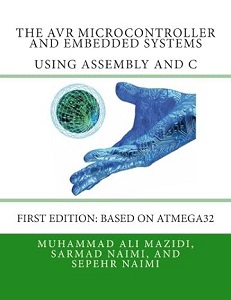Chapter 0: Introduction to Computing
Chapter 0: Introduction to Computing (Updated)
Chapter 0: Introduction to Computing (Original)
Chapter 1: The AVR Micro-controller: History and Features
Power Point: Introduction to AVR
Additional Resources:
AVR and AVR32 Quick Reference Guide Microchip download link
Chapter 2: AVR Architecture and Assembly Language Programming
Assembly Programming in Atmel Studio 7.0 step by step tutorial
Chapter 3: Branch, Call, and Time Delay Loop
Chapter 4: AVR I/O Port Programming
Appendix C: IC Interfacing and System Design Issues
AVR Simulation in SimulIDE Step by Step Tutorial (Case Study)
Chapter 5: Arithmetic, Logic Instructions, and Programs
Chapter 6: AVR Advanced Assembly Language Programming
Lab: Arithmetic instructions & BCD
Lab: Logic instructions & Bit Manipulation
Chapter 7: AVR Programming in C
C programming in Atmel Studio 7 step by step tutorial
Section 7.1.2: Creating a time delay in Atmel Studio
Section 7.6.2: Using Flash data space to store data in Atmel Studio
Chapter 8: AVR Hardware Connection, Hex File, and Flash Loaders
AVR Simulation in SimulIDE Step by Step Tutorial
Extra Resources (Case Study):
AVR Hardware Design Considerations
Chapter 9: AVR Timer Programming in Assembly and C
Chapter 10: AVR Interrupt Programming in Assembly and C
Chapter 11: AVR Serial Port Programming in Assembly and C
Simulating the AVR UART in SimulIDE
Chapter 12: LCD and Keyboard Interfacing
Simulation: LCD Simulation in SimulIDE
Simulation: Keypad Simulation in SimulIDE
Chapter 13: ADC, DAC, and Sensor Interfacing
Simulation: ADC simulation in SimulIDE
Chapter 14: Relay, Optoisolator, and Stepper Motor Interfacing with AVR

Chapter 15: Input Capture and Wave Generation in AVR
Lab: Measuring duty cycle & Frequency using Capturing
Simulation: Using Oscope in SimulIDE to Monitor Waves
Chapter 16: PWM Programming and DC Motor Control in AVR
Simulation: DC-motor and PWM Simulation in SimulIDE

